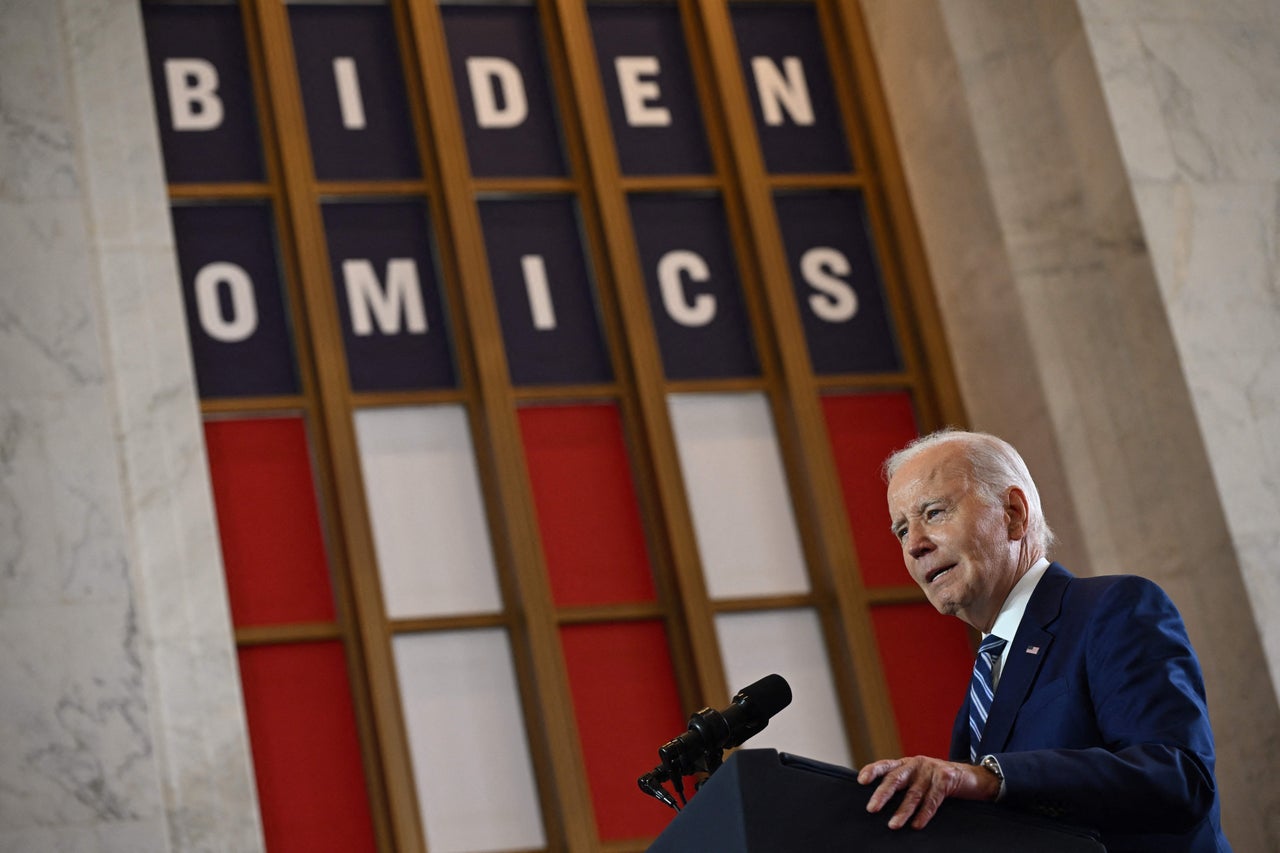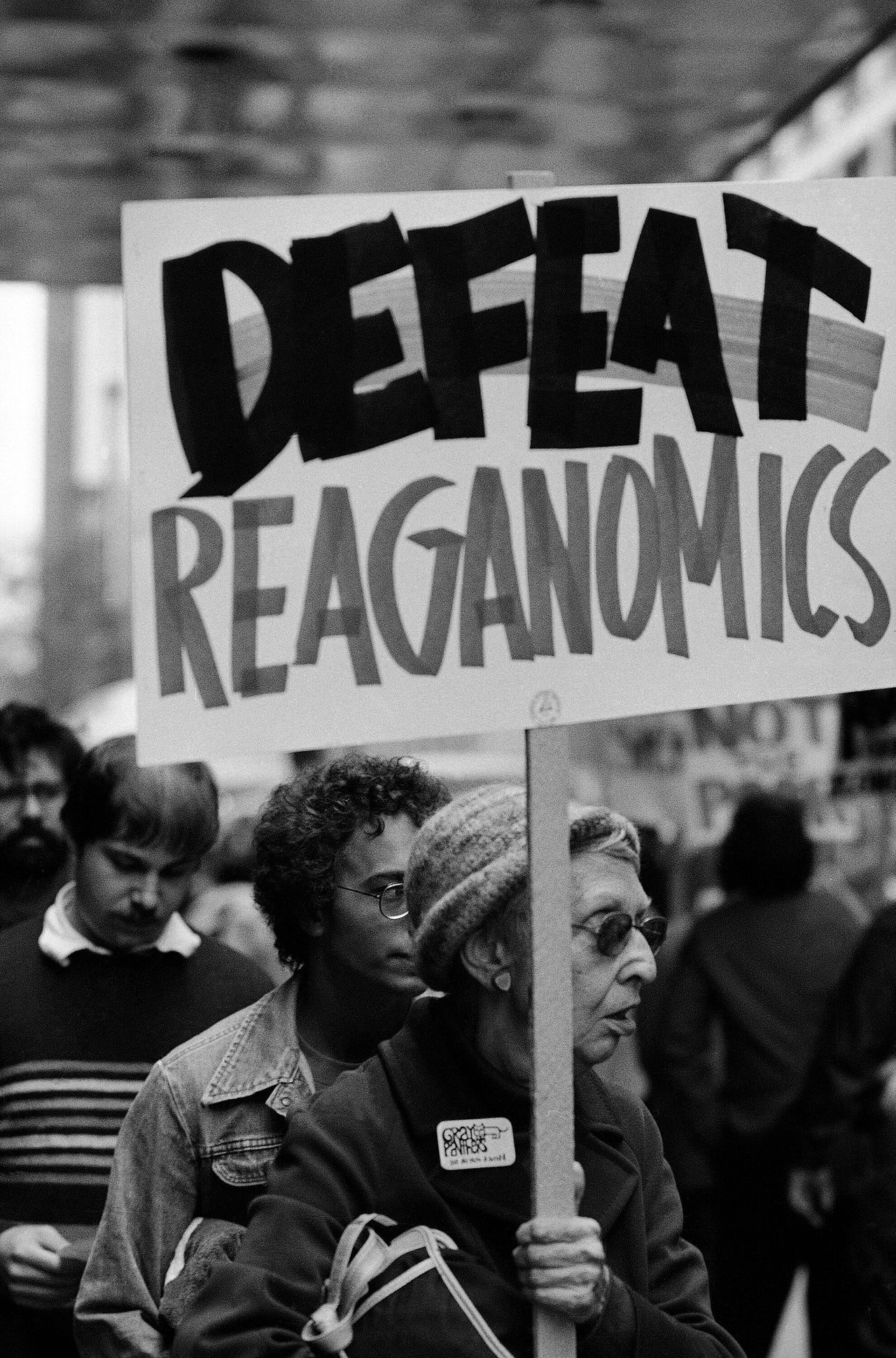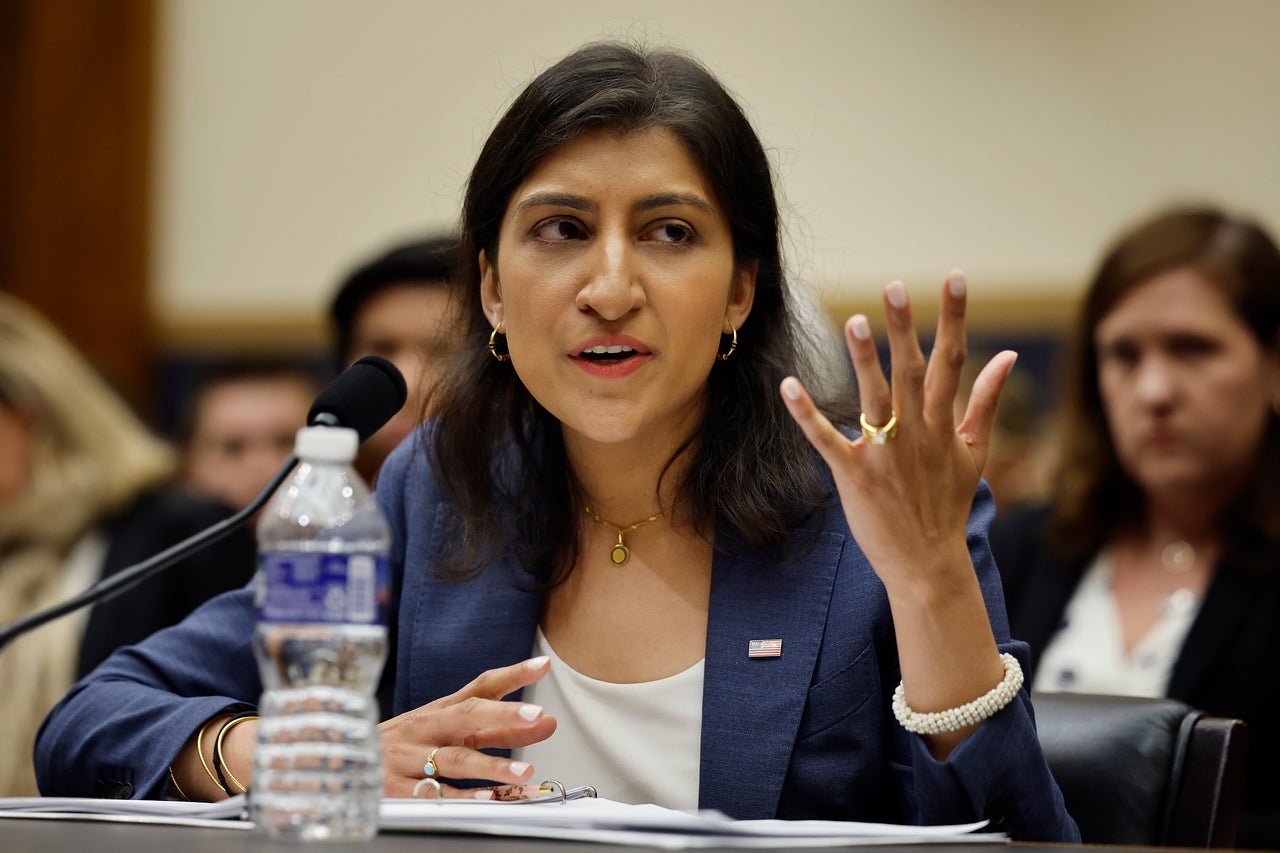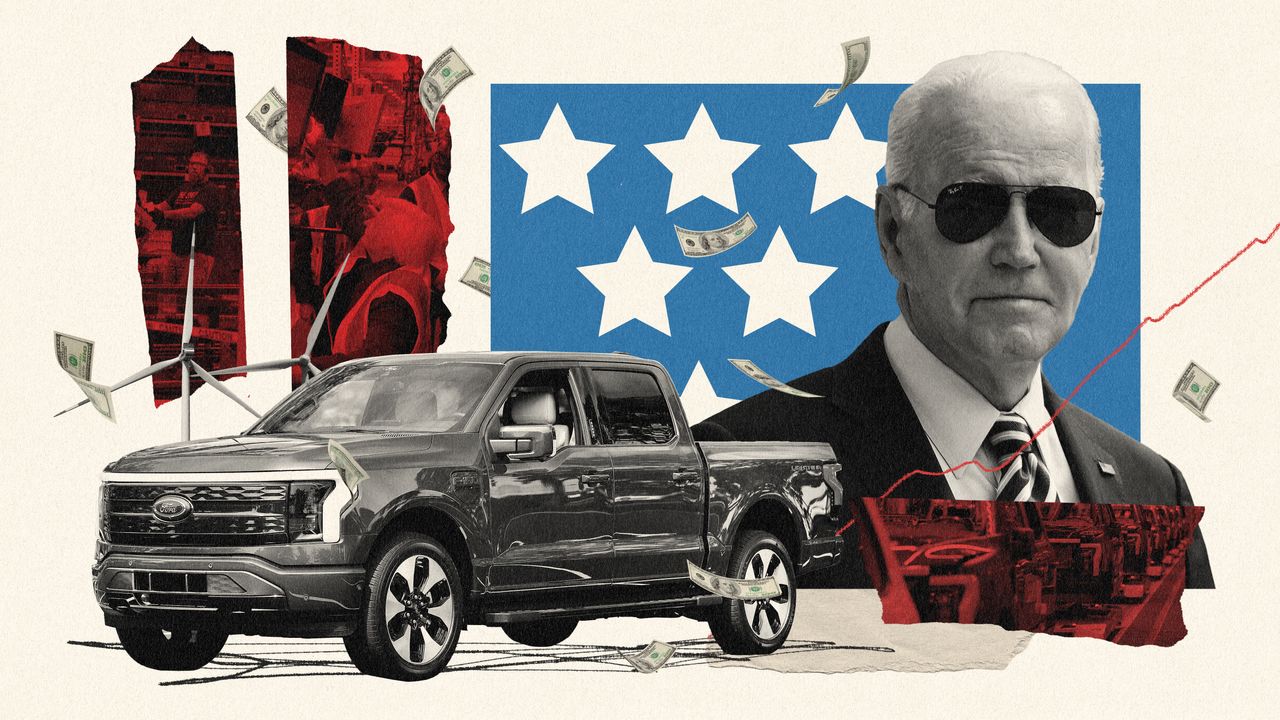In late June, when President Joe Biden took the stage at the Old Post Office building in Chicago to declare a “fundamental break” from the “trickle down” economic paradigm that has ruled American politics for more than 40 years, he insisted the self-congratulatory name for his economic program was not his idea.
“Bidenomics” came from The Wall Street Journal and the Financial Times, Biden said.
“I didn’t come up with the name,” he said. “I really didn’t.”
Even if the name was unplanned, the fundamental shift it has come to symbolize was not. Bidenomics is the result of a conscious effort by the White House to undo a free-market paradigm that swept into Washington with President Ronald Reagan’s election — one that favored the private sector over the public, the financial well-being of the rich over the poor, the support of monopolies over small and local business, and the empowerment of bosses over workers.
After two years of working to pass high-profile economic legislation and rolling out comparatively obscure new government rules, Biden is ready to take credit for what could prove to be a sea change in American politics and economic life. Say goodbye to Reaganomics and hello to Bidenomics.
Bidenomics, as the president and his administration tell it, puts the government back in the driver’s seat through the direction of industrial policy in key sectors deemed important to national and economic security. And it prioritizes worker empowerment and competition through the reinvigoration of labor unions and antitrust enforcement.
The changes sweeping across government and the economy can be seen from almost every angle, from the unprecedented public investment happening through the Inflation Reduction Act, bipartisan infrastructure law and the CHIPS and Science Act, to the reversal of decades of pro-monopoly antitrust policy or the rewriting of the regulatory review process.

Private companies, spurred on by the government’s public investments in the economy, have already announced more than $500 billion in investments in factories across every single state. Manufacturing construction is booming. Unemployment has remained under 4% for the longest stretch in 50 years. The lowest-wage workers have seen significant wage gains, leading to a decrease in overall inequality. And, most importantly, as inflation has fallen over the past year, real wage growth finally outpaced the rate of price growth for the first time since the early months of Biden’s presidency.
“We have seen a skyrocketing in investment in construction for manufacturing facilities that’s off the charts. That is very exciting to see,” said Heather Boushey, a member of Biden’s Council of Economic Advisers and the chief economist for his Investing in America agenda. “And that alongside the statistics that we’re already seeing like good jobs being created, how many of the wage gains have been at the bottom end of the wage distribution. This is exactly where the president wanted us to be by now.”
With his speech in Chicago, Biden is betting big that this good economic news will continue and allow him to run for reelection on the paradigm shift that is already underway. Finishing the shift will require successfully selling its start to the American public and contrasting it to the one his Republican opponents would put in place. Will the good news trickle down in time?
The Old Order
“In order to understand what this paradigm shift means, you have to start by asking, well, what was the paradigm before?” said Felicia Wong, president and CEO of the Roosevelt Institute, a left-leaning think tank and a key source for the administration’s economic ideas.
In Chicago, Biden referred to the old paradigm as “trickle-down economics.” This was a way of describing Reagan’s policy idea that the money unlocked by cutting taxes on the rich would spur business investment and growth. The benefits of that growth would ultimately trickle down to the middle and lower classes. A rising tide for the rich would lift all boats.
The free-market fundamentalism that ended up taking Reagan’s name first emerged out of the turbulence of the 1970s, when the economic ideas of the New Deal regime seemed to run out of gas. As the country faced stagnant growth, high inflation, labor unrest and a string of high-profile bankruptcies, including New York City’s, a new version of classical liberal economics — as in the laissez-faire theories that dominated pre-New Deal America — stepped into the breach.
This neoliberalism rejected the government’s role in the economy, instead preferring the private financial industry to manage the country’s economic governance. It sought free trade that disfavored local economies of place for lower prices and greater efficiencies created by on-time global supply chains. It favored industry deregulation, corporate consolidation, a small welfare state and leaving the private sector to its own devices.

The changes Reagan instituted, including tax cuts, welfare reductions, the suppression of strikes, dramatic deregulation of business, and the gutting of antitrust enforcement, ushered in a conservative age. Fifteen years after Reagan entered the White House, a Democratic president, Bill Clinton, declared, “The era of big government is over.”
While growth rebounded from the stagnation of the 1970s, it didn’t last. The benefits never managed to trickle down, either.
“It led mostly to really, really, really significant concentrations of wealth at the very top and it led to inequality and stagnation of wages,” Wong said. “What you really see is that this kind of neoliberal economics didn’t play out in practice.”
The New Order
The neoliberal order ran aground in 2008 with the onset of the global financial crisis and the Great Recession. The resulting recovery was slow and uneven, with the government failing to put enough resources into the economy to bounce back quickly. Political upheavals followed as the neoliberal economics of austerity and free trade provided no answers to the problems revealed by the crisis. Right-wing populists like Donald Trump and democratic socialists like Sen. Bernie Sanders (I-Vt.) emerged with critiques of the existing economic order. But it was Trump who won, at least at first.
Like Jimmy Carter before Reagan, Trump presaged a shift in the economic paradigm. While he lurched away from the neoliberal consensus on trade and made feints in other areas, the internal incoherence of his party and his own personal incapacities made a full shift impossible. This came into full relief when the COVID-19 pandemic struck and he presided over the greatest spending wave in U.S. history in order to keep businesses from closing and people from going broke. And then Biden came in and brought coherence to the shift that was already underway.
Biden’s administration “is the first post-neoliberal administration,” said Sohrab Ahmari, a supporter of Trump’s 2020 bid whose forthcoming book, “Tyranny, Inc.,” examines how excessive corporate power undermines democracy.
“It shows a nimbleness on the part of the center-left elite in this country that even as they ferociously fought the Trump phenomenon ... they also took in his critique, they absorbed his critique,” said Ahmari, a founder of Compact magazine.
The four years of the Trump era saw great ferment in academic economic research and the think tanks associated with the Democratic Party, including the Roosevelt Institute and the Washington Center for Equitable Growth, which Boushey founded. The activism around Occupy Wall Street earlier in the decade and the presidential campaign of Bernie Sanders also provided a significant grassroots network capable of backing up new economic ideas.
“There’s a clear throughline between the academic ideas, the policy ideas, the people and then the actual policy agenda,” Wong said. “The period between 2016 and 2020 was when all of these ideas came together.”
The pillars of what the administration is selling as Bidenomics came out of this period: the enactment of industrial policy through public investment, a reinvigoration of antitrust policy and the empowerment of workers.
“It shows a nimbleness on the part of the center-left elite in this country that even as they ferociously fought the Trump phenomenon ... they also took in his critique, they absorbed his critique.”
- Sohrab Ahmari, a founder of Compact magazine
Chief among these policies is the resurrection of a robust and publicly stated industrial policy orchestrated through direct public investment. This idea of an economy curated by the government has received a variety of different names from economists including “new productivism,” “the mission economy,” “marketcrafting” and “the designer economy.” Whatever you want to call it, it favors a strong hand for the government to support and invest in industries deemed important to the national and economic security of the country.
“Bidenomics really refers to a theory of economic growth,” said Todd Tucker, director of industrial and trade policy at the Roosevelt Institute. “In a similar way that Reaganomics was about pulling the public sector out of the economy and you’d have a trickle-down effect to create jobs, Bidenomics is opposite of that. It prioritizes catalytic public investment.”
What Tucker means is large, government-funded public investment is designed as a catalyst to “crowd in” private investment by stating very clearly which investments in specific industries the government has deemed important to the national and economic security of the country.
Under Biden, those industries include those necessary to tackle climate change and the supply chain vulnerabilities revealed by the COVID-19 pandemic.
So far, the White House’s theory of public investment as a catalyst is proving true: The direct public investment — more than $1 trillion between the IRA, CHIPS and infrastructure laws — has already led companies to announce manufacturing investments exceeding $500 billion.
This was a new idea whose time had come, as then-National Economic Council Director Brian Deese told The Economic Club of New York in April 2022.
“For much of the last half-century, even uttering the words ‘industrial policy’ was met with something between derision and concern,” Deese said. “But our economy has changed, and the world has changed, too.”
The Death Of The ‘Washington Consensus’
Beginning in the 1980s — and to an even greater degree after the fall of the Soviet Union — a bipartisan “Washington Consensus” on trade favored the free flow of goods and people, with jobs overshored to countries with the cheapest workforces in order to build efficient supply chains connected by shipping lanes. To top it off, this vision of free trade was buoyed by a mythology that promised economic liberalization would lead to political liberalization in places like China.
The politics of this consensus created tricky problems for domestic dissenters, especially labor unions, which often found themselves between a rock and a hard place. The Republican Party had become so staunchly anti-union that stopping the party from controlling the White House was always seen as a top priority.
But Democratic presidents, while eager for organized labor’s support in election season, were often beholden to a lighter version of the free-trade orthodoxy that dominated the GOP. Clinton signed the North American Free Trade Agreement in 1993, and signed another bill permanently lowering trade barriers with China in 2000. The changes resulted in the flight of domestic manufacturing jobs to Mexico and China, respectively. And while Barack Obama campaigned on renegotiating NAFTA to put American workers at less of a disadvantage, he never delivered.
Two things happened in the 2016 election cycle, however, that changed the trajectory of both major parties on trade.
First, in the Democratic presidential primary, Sanders struck a nerve with his trenchant critiques of former Secretary of State Hillary Clinton over her support for business-friendly trade agreements like the Trans-Pacific Partnership. And more importantly, Trump defeated Clinton in the general election in part by running as a more reliable champion for domestic manufacturing jobs and attracting the votes of current and former union workers in the Rust Belt.

“Bernie and Trump sounded the alarm saying: ‘American workers have been wronged. Communities have been left out. You’re spending too much time flying to Berlin and Ireland and Davos,’” said Rep. Ro Khanna (D-Calif.), who recently completed a listening tour with workers in post-industrial towns in Pennsylvania and Ohio. “‘And you’re not spending enough time in Ashtabula and Johnstown and Youngstown.’”
At the same time, some longtime trade policymakers started to rethink the consensus after the grant to China of favored nation trade status did not lead to its democratization. Instead, the opposite happened, with the political system closing off itself further. Then in 2015, China announced a direct break with the neoliberal order with its own state-backed industrial policy initiative, “Made In China 2025.”
“There was a real shift even among elite trade policymakers who realized that the thing we tried to do all these years to get China to adhere to a neoliberal order is not working,” Tucker said.
Once in office, Trump took significant steps to remedy what he thought were aspects of trade agreements that had hurt the United States. He started a trade war with China, putting tariffs on key imports like steel. He shelved the Trans-Pacific Partnership. And he renegotiated NAFTA such that it included stronger worker protections, even though House Democrats, who overwhelmingly backed the new law, took credit for insisting on the latter in their own negotiations with the White House.
Although they are loath to admit it, Biden and other Democrats apparently took note of the fact that Trump had capitalized on the legitimate grievances of working-class communities in the Midwest and vowed to avoid a repeat of the drubbing they had endured in those areas in 2016.
To wit, Biden has preserved core parts of Trump’s trade agenda. In 2019, Biden said he would renegotiate the TPP, rather than keep it on ice, but he has not acted on those plans since taking office. He also essentially preserved Trump’s tariffs on China.
Antitrust And Regulation
The third area where Biden has broken with the old guard is the revamped way the government engages in antitrust enforcement and reviews regulations.
By appointing antitrust hawks Lina Khan and Jonathan Kanter to be Federal Trade Commission chair and top antitrust official at the Justice Department, respectively, Biden signaled a 40-year-old bipartisan consensus on competition policy would change.
For most of the country’s history, a Republican fear of centralized power fed an opposition to large corporate behemoths. The anti-monopoly movement of the 19th century secured the enactment of the Sherman Act to combat large trusts. The accepted idea behind antitrust law was to block the centralization of power in monopoly corporations that could harm competition, workers, consumers and suppliers.
Reagan’s ascension to the presidency brought with it a new point of view that favored big corporations. On the theory of the legal scholar Robert Bork, the administration adopted a consumer welfare standard that viewed mergers and acquisitions strictly through the lens of whether they would raise prices for consumers.
In July 2021, Biden issued a competition policy executive order that directed nearly every agency to align their competition policies to a new antitrust thinking prioritizing workers, suppliers, small business and market power while lowering costs.

This administration policy has led to a ban on worker noncompete agreements, reductions in overdraft fees, protections for independent poultry farmers, rules to make it easier to cancel a subscription and new rules for airline cancellations, among many other things.
Most importantly, the FTC and DOJ antitrust office have pursued an aggressive antitrust legal strategy successfully challenging mergers that threaten competition and markets in multiple industries.
On Wednesday, Biden announced that the FTC and DOJ antitrust office had released new draft guidelines for how the two agencies will challenge mergers and how courts should judge what the agencies do. The new guidelines effectively end the 40-year reign of the Borkian consensus.
Another piece of Bidenomics is coming together in a little-known White House office that got its start under Reagan. The Office of Information and Regulatory Affairs, housed in the Office of Management and Budget, was tasked by Reagan with performing cost-benefit analysis on regulations issued by federal agencies. This process turned this small office into a bottleneck for the regulatory process as it applied a discount rate that didn’t give much weight to benefits that would accrue in the future. This created special challenges for climate change regulation.
“Under the old discount rate you would be vastly undercounting the benefits of mitigating climate change and overweighting the present-day cost,” said K. Sabeel Rahman, a Cornell Law professor who served as acting administrator of OIRA under Biden until January 2023.
That all changed in April with a new set of best practices for calculating costs and benefits. Under the new system, future benefits from regulations would receive much greater weight in an analysis. This promises to unlock and speed the approval process for environmental and climate-related regulations in the coming years.
Meanwhile, OIRA also implemented new recommendations for agencies to use when crafting regulations on equity and competition. These include ways that agencies should structure regulations to think about impacts based on geography, income, race and sexual orientation. On competition, the new guidelines inform agencies how to write regulations that take market power and impacts on wages into account.
“When you think about what Bidenomics’ big picture is about, it’s about looking at our political economy and the market system as a whole and trying to make it more inclusive and more dynamic and responsive to the public’s needs,” Rahman said. “Those are the kind of big picture things that old-school analytic approaches would not represent accurately.”
Centrist Skepticism, Progressive Pique
Not every Democrat is pleased with Bidenomics.
Some of the centrist neoliberal economists who served in the Obama and Clinton administrations continue to believe that lowering international trade barriers is a net benefit to the U.S. economy, and that the short-term benefits of taking proactive steps to boost specific manufacturing sectors is an inefficient way of creating high-paying jobs.
“I don’t think the problem in America today is too many people working or working people are making too much money.”
- President Joe Biden
“If you think of it as a way to tackle climate change or improve American security, I think it’s quite good,” said Jason Furman, a Harvard economist who served as Obama’s top economic adviser, alluding to the benefits of insulating supply chains from geopolitical conflict with China and other nations. “If you think it’s a great way to create jobs and help the middle class, I think you’re delusional.”
He believes that Biden’s COVID-19 bill was too big and contributed to inflation. However, he credits Biden for supporting the Federal Reserve’s rapid interest rate hikes, which he believes have helped tame inflation.
“I am more of a fan of President Biden than I am of their description of ‘Bidenomics,’” he said.
More left-leaning policy experts welcome that kind of criticism.
“Summers and Furman are more worried about the error of overspending and how that shapes the deficit and inflation,” said Lindsay Owens, executive director of Groundwork Collaborative, a left-leaning economic nonprofit, also referencing former Treasury Secretary Larry Summers. “Boushey and [Jared] Bernstein are more worried about underinvestment and how that shapes the lives of millions of Americans and the labor market trajectory. These aren’t just different personalities, these are different ideologies.”
One of the big differences between Furman and his mentor Summers on the one hand, and the Biden administration on the other, is that Biden never pushed for the Federal Reserve to fight inflation by increasing interest rates high enough to cause a recession.
“Remember, the experts said: to get inflation under control we need to lower those wages and drive up unemployment,” Biden said on Wednesday. “But I’ve never bought that. I don’t think the problem in America today is too many people working or working people are making too much money.”
Owens has taken notice of Biden’s careful rhetoric on the topic. “Biden deserves a lot of credit for never endorsing the idea that we need to destroy the labor market,” Owens said.
Selling ‘Bidenomics’
The question facing Biden’s reelection campaign now is: In a country where the working and middle classes have suffered decades of wage stagnation, and consumer prices have been receding only gradually, will voters feel the impact of Biden’s policies enough to make a difference in the 2024 election?
One answer comes courtesy of Rep. Marcy Kaptur (D-Ohio), who has held on to her GOP-gerrymandered Toledo-area seat in part due to her unflagging commitment to reviving Midwestern industry. In a region once starving for blue-collar jobs, Kaptur told HuffPost that the challenge is now finding enough skilled workers to fill them.
“When I go into companies — no matter how large or small — they say, ‘Marcy, I need workers. Marcy, I need trained workers. Marcy, I need 200 steel workers. Marcy, I need people to work in our controlled environmental agriculture facilities,’” Kaptur said.

“So Bidenomics — he talked about reaching down to the bottom up and the middle out? Boy, is that happening in our part of Northern Ohio — all over Ohio!” she added.
But aside from getting money out the door and shovels into the ground, the administration will need to balance their stated goals of presiding over a manufacturing boom that leads to a clean energy transition and stable domestic supply chains while also making sure the jobs it creates are good-paying union jobs and the money corporations receive doesn’t just go back into their own pockets through share buybacks.
But Khanna, a Silicon Valley Democrat who has gotten major technology companies to invest in small towns in the Midwest and Appalachia, came away from his tour of industrial towns convinced that the administration has more work to do connecting with frustrated voters in those communities.
“I just think we need to be out in these communities listening — not being like, ‘Yay, we’ve done the IRA, we’ve done this.’ It doesn’t connect because people are still having a hard time,” he said. “But listening and saying, ‘You’ve been wronged. The last 40 years has been a failure of leadership. You’re right to be angry. ... What more do you need?’”
Regardless of whether Biden takes Khanna up on the recommendation, he is likely to have the advantage of a Republican presidential nominee without a strong critique of Biden’s economic record.
While some conservatives have embraced an economic paradigm shift that centers a robust industrial policy and a government-curated economy, the leading Republican presidential candidates have not. Both Trump and Florida Gov. Ron DeSantis (R) have invariably called for repealing the Inflation Reduction Act; gutting the federal civil service; disbanding the IRS; eliminating the Commerce Department, which oversees the semiconductor funding in the CHIPS law; eliminating climate regulations; and, in general, drastically weakening government capacity.
But that’s if the GOP nominee focuses on the economy at all. Thus far, the Republican presidential primary has been defined, in part, by fights over U.S. policy in Ukraine and cultural questions like how to discuss gender identity in schools. DeSantis, in particular, has turned his candidacy into a referendum on the ill-defined phenomenon of “wokeness.” Trump barely mentions trade on the stump, and recently wondered aloud why his attacks on transgender Americans are so popular with the GOP base.
Up against a message of reviving domestic manufacturing and ensuring that prosperity is shared with workers, Democrats believe the right’s focus on culture is likely to fall short — much as it did in the 2022 midterm elections.
Meanwhile, proponents of the Bidenomics paradigm shift point to some of the pieces of the president’s Build Back Better agenda that didn’t make it into the Inflation Reduction Act like government funding for the care economy through child care, health care and education, a full industrial policy for the entire clean energy transition, and raising taxes on the wealthy that will be needed to complete the shift.
“It’s really fricking early,” Owens said. “You’re not going to undo Reaganomics overnight.”
Arthur Delaney contributed reporting.
